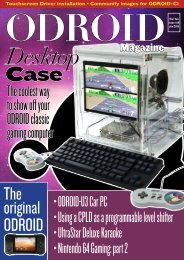Lamp
ODROID-Magazine-201509
ODROID-Magazine-201509
- No tags were found...
Create successful ePaper yourself
Turn your PDF publications into a flip-book with our unique Google optimized e-Paper software.
XU4 CLUSTER<br />
XU4 Cluster<br />
a THOROUGH look AT several<br />
AVAILABLE options for HIGH<br />
PERFORMANCE COMPUTING<br />
by Alan Mikhak<br />
I<br />
evaluated a set of ODROID-XU4/XU3 devices as an<br />
embedded cluster platform for parallel computing with<br />
OpenCL and MPI using Heterogeneous Multi-Processing<br />
(HMP) Linux. As a software consultant, the purpose of this<br />
evaluation was to add more tools to my toolbox so that I can<br />
offer better service to my clients.<br />
Project goals<br />
I started with a few requirements in mind. I was looking<br />
for a platform based on ARM Cortex-A9 CPU cores at<br />
a minimum, paired with a GPU which could run Ubuntu<br />
Unity desktop with hardware accelerated graphics, supporting<br />
OpenGL, OpenCL and CUDA with floating point and vector<br />
math hardware. I just didn’t want to run the cluster nodes in<br />
headless mode. Having a popular desktop on each node was<br />
and still is on my wish list. A WiFi interface would also be a<br />
bonus so that I can evaluate wireless clusters.<br />
Evaluations<br />
At first, I considered platforms based on the Freescale i.MX6<br />
Quad processor, which has four Cortex-A9 cores. I evaluated the<br />
Wandboard Quad board which pairs a Vivante GC2000 GPU<br />
with the i.MX6 CPU. It also includes a Broadcom BCM4329<br />
WiFi interface. I had used a Wandboard Duo a few years before<br />
with an earlier version of Ubuntu desktop running on it. However,<br />
no matter what I tried, I just couldn’t get Ubuntu 14.04 Unity<br />
desktop to run on the Wandboard Quad and detect my Samsung<br />
SyncMaster BX2431 HDMI monitor at the time that I tried.<br />
To run Ubuntu 14.04 Unity desktop smoothly, I would<br />
need a platform that supported the full desktop OpenGL, not<br />
just OpenGLES. I also needed hardware acceleration for X-<br />
Windows. I started considering platforms based on Samsung<br />
Exynos 5 Octa which has four Cortex-A15 and four Cortex-A7<br />
CPU cores as well as an integrated ARM Mali T628MP6 GPU.<br />
I purchased a Samsung Chromebook II which ran ChromeOS<br />
with graphics acceleration. The Chromebook has a built in<br />
monitor, keyboard, track-pad, and WiFi. This seemed to be an<br />
advantage in my case, considering the cost of the USB HDMI<br />
KVM switches and HDMI monitors. Each Chromebook II<br />
A XU4 cluster being managed by an XU3 console<br />
node would be self-sufficient. I put the Chromebook II in<br />
developer mode and installed Ubuntu 14.04 but again couldn’t<br />
get Unity desktop to run on it at that time.<br />
I then evaluated an Arndale Octa board which is also based<br />
on the Exynos 5 Octa. Arndale Octa seemed promising because<br />
www.linaro.org listed recent support for it. Again, no<br />
matter what I tried, I still couldn’t get Ubuntu 14.04 Unity<br />
desktop to come up on the Arndale Octa board and detect my<br />
Samsung HDMI monitor.<br />
I moved on to evaluating the ODROID-XU3 which is also<br />
based on the Exynos 5 Octa. The Hardkernel website showed that<br />
the Ubuntu MATE desktop was already running with smooth acceleration.<br />
HMP support was also on the horizon in Ubuntu Linux<br />
kernel. The ODROID-XU3 was the best match so far because it<br />
actually booted into an Ubuntu graphical desktop with my Samsung<br />
HDMI monitor. However, I decided to keep looking for a<br />
platform that could run the Unity desktop which I was used to.<br />
I switched to evaluating the Nvidia Jetson TK1 development<br />
kit based on the Nvidia Tegra K1 SoC which integrates<br />
four ARM Cortex-A15 CPU cores and 192 Nvidia Kepler<br />
GK20A CUDA GPU cores. The Jetson TK1 is actually the<br />
first platform I evaluated that runs Ubuntu 14.04 Unity desktop<br />
smoothly with graphics acceleration. I then added a second<br />
Jetson TK1 to bring up a two-node cluster for evaluating<br />
ODROID MAGAZINE 17



